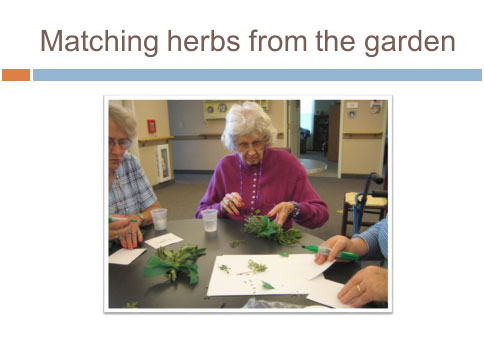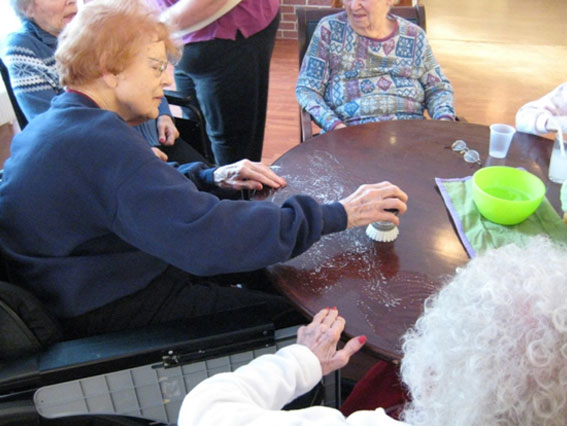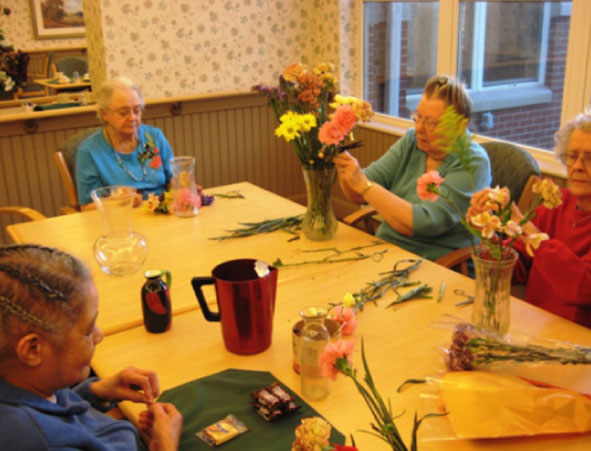The Montessori Method is based on the use of the five senses and on the procedural memory system. The procedural memory system is responsible for learning associative relations, simple conditioning, and motor and cognitive skills. Procedural memory is sometimes referred to as implicit, non-declarative, unconscious or muscle memory. People who are living with dementia and Alzheimer’s tend to be able to continue to use those skills learned through procedural memory. Caregivers, whether medical staff, front line workers or family members, can use Montessori tools to help the people they care for maintain spared skills. For example, a caregiver can demonstrate how to use the Montessori zipping frame to help a person with Alzheimer’s maintain their ability to dress themselves.
This frame isolates the task of zipping and gives the user the opportunity for repetition. It is through repetition that people are able to tap into procedural memory to maintain, improve or relearn a skill.
While older people may deal with diminishing strength in their sense of sight, hearing, touch, smell and taste, the Montessori Method encourages caregivers to use the remaining senses as a means of stimulating the brain, and as a successful means for creating engagement and reconnection. Natural, real-world material can be very powerful prompts for stimulation, engagement and reminiscence. Bringing in fresh herbs from the garden for people to hold, smell or taste is a simple but very evocative exercise.
Jack, once a professor at a prestigious university, was captivated by the sprays of sage, lavender, thyme and rosemary. He rubbed the velvety leaves of the sage in his fingers and brought the lavender to his nose, breathing in the perfume. Jack began to talk about growing up on a farm and gathering herbs from his mother’s kitchen garden. Usually a man of few words who showed little emotion, Jack began to sing, “Are You Going to Scarborough Fair?” These simple herbs touched Jack deeply, and helped him remember some wonderful memories of his childhood.

In addition to providing older people with the opportunity to experience meaningful moments, it is also essential to provide a safe, pleasing and uncluttered environment. Central to the Montessori Method is the belief that intentional communities (whether adult day, long term care or family homes) should be created to serve the needs of the people in these communities. The needs that should be addressed in the environment include physical safety, ease of use, and the aesthetic need for beauty and order. The people using the environment should be given the opportunity to help care for this environment, whether this means caring for a plant or animal, or polishing a window or setting the table for meals. People feel connected to their space when they take some responsibility for it.

The Montessori Method provides caregivers the opportunity to create a calm, inviting and joyful experience for people who are living with Alzheimer’s and dementia. This method can be used as a bridge to reach people who may seem unreachable. The Montessori Method stresses identifying each person’s strengths and building an individualized program that engages the whole person, including cognitive, physical and emotional aspects. This approach to dementia care is rooted in the philosophy that people grow in confidence and self-esteem when they are given the opportunities to be successful and to accomplish meaningful work. While the Montessori exercises or tools are uncomplicated, they are not childish or simplistic. These tools provide visual cues and tangible prompts that lead to feelings of accomplishment and well- being.
The Application:
The Montessori Method can be used throughout the course of dementia, from the beginning of symptoms to the final stages. Medical staff, frontline staff and family caregivers can all learn to use this method. Learning the method and how to work with the related tools means understanding the philosophy of person-centered care that is central to Montessori. The Montessori tools are those materials that can be purchased or made by staff or family members.
Dorothy was an avid gardener all of her life. When she was diagnosed with Alzheimer’s, her family kept her at home until she began wandering at night. Concerned for her safety, Dorothy’s family found a memory enhancement center within a long term care facility. Learning of Dorothy’s years of gardening, the staff asked her if she would like to join the weekly flower arranging group. Dorothy was reluctant at first. She was inclined to stay in her room and not to socialize. The staff members began bringing Dorothy some of the flower arrangements each week, putting them in her room. Gradually, Dorothy grew curious about the group that supplied her with bouquets each week. She began by just watching and then she started to participate. Dorothy is now a group leader of the flower arranging club, encouraging other residents to join the weekly meeting.
Arranging flowers gives people with dementia and Alzheimer’s the opportunity to be creative once again. It also provides them with the challenge of using logic and judgment in deciding how much to trim from the flowers, which vase to use and how to arrange the flowers themselves. The work is then shared with the community, bringing happiness to everyone who sees the flowers.

The Montessori Method for positive dementia care can be applied in conjunction with all other person-centered care programs. This method can be incorporated into all activities of daily living, and can serve as the foundation for many meaningful and engaging exercises and activities. Our positive approach to dementia care has proven to be highly beneficial to the people living with dementia, their loved ones and caregivers. The Montessori Method for Positive Dementia Care is an accessible, sturdy and hopeful path to reach and engage people who are living with dementia. We do not travel this pathway alone. Reading the Fisher Center’s blog is a great way to stay in touch and learn from our fellow travelers!









